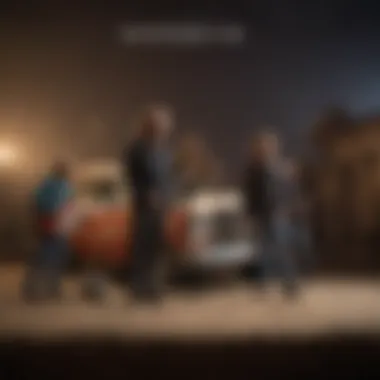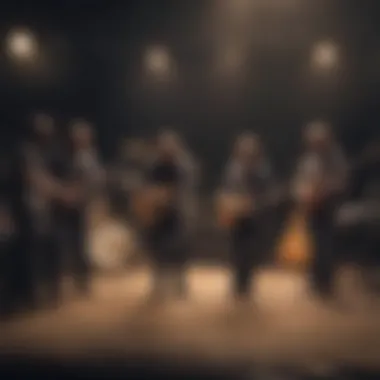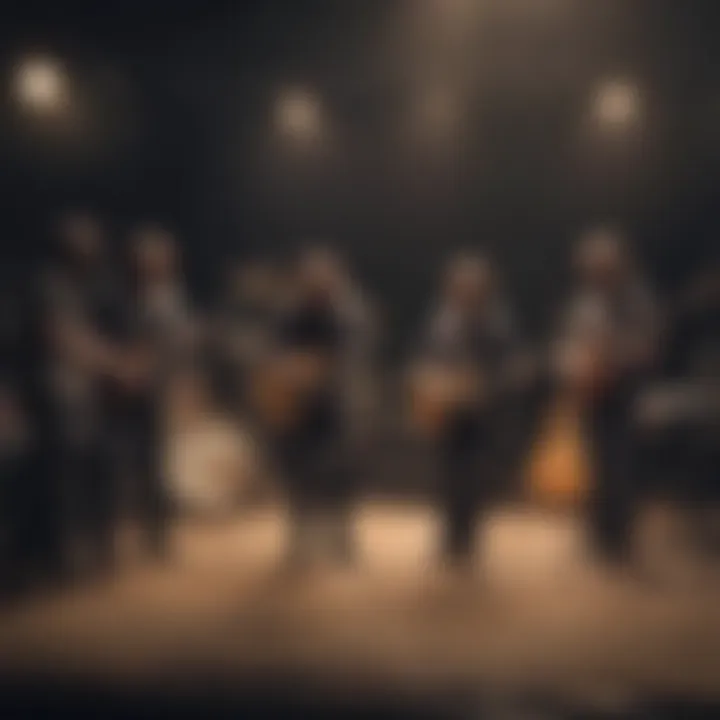Exploring Mudcrutch: The Band's Impact on Rock Music


Intro
Mudcrutch remains a curious yet pivotal chapter in the annals of rock music. Typically remembered as the band that served as the stepping stone for some familiar faces, including Tom Petty, Mudcrutch's musical legacy stretches far more than just a forgotten blip in the timeline of American rock. This article seeks to examine the intricate tapestry of music, history, and influence surrounding Mudcrutch, from their genesis in the sweltering streets of Gainesville, Florida, to their refinement and resurgence in the modern music scene.
Understanding Mudcrutch's contributions involves diving into their initial formation, major influences, and the dynamics of their sound. Within these pages, we'll analyze their discography and artifacts to see how their style encapsulated and influenced rock and beyond. Key albums will come under scrutiny, revealing not only the craftsmanship behind their songs but also the enduring impact they have left on aspiring artists.
Artist Profile
Biography and Background
Mudcrutch was birthed in the early 1970s from an eclectic mix of friends and musicians yearning to carve out their place in the bustling American rock landscape. Formed in 1970 in Gainesville, this ensemble burst forth with a laid-back style that combined elements of rock, country, and folk. Members included the ambitious Tom Petty, Mike Campbell, Benmont Tench, Tom Leadon, and Randall Marsh. Each brought distinct flavors, which contributed to the band's rich, homogenous sound. They're the kind of names you stroke your chin over, knowing they helped shape music that would hold up through the years.
Following a brief yet memorable stint that saw some success—if not the mainstream popularity they craved—Mudcrutch disbanded in 1975, relocating many of its members into different ventures. But it was not the end. These musicians would go on to impact rock music as individual artists and as a cohesive unit in later years.
Major Influences and Inspirations
The sound of Mudcrutch didn’t emerge in isolation. It blended the influences of the burgeoning rock scene of the late sixties and early seventies. Bands like The Byrds, The Band, and Creedence Clearwater Revival generated electric excitement, merging harmony and rhythm in innovative ways. These groups not only colored their musical palette but also paved the way for their work in Mudcrutch.
Tom Petty himself often cited the blues—be it Muddy Waters or Howlin' Wolf—as essential to his aggressive yet infectious sound. This provided a driving force behind Mudcrutch's energetic performances. Other influences emerged from folk and country traditions of artists like Hank Williams, which lent depth and authenticity to their lyrics.
The resulting fusion led to a signature unmistakable sound, merging storytelling and sonic experimentation, which would resonate with listeners but perhaps not yet find a proper commercial foothold.
Song Analysis
Theme and Lyrics Breakdown
Mudcrutch's lyrical themes regularly touched on life’s existential questions, love, and departure—subjects deeply ingrained in the fabric of rock music. Their songs often captured the transient nature of relationships and the bittersweet tang of nostalgia.
Preamble to Mudcrutch
Understanding Mudcrutch is key to appreciating the fabric of rock music in the late 20th century. The band occupies a significant position not merely as a chapter in Tom Petty's story, but as a unique entity that shaped his musical journey. Mudcrutch's blend of rock, folk, and country influences resonates even now, echoing through the work of various artists. To comprehend their impact, one must consider not only their sound but also their cultural timing.
Historical Context
In the early 1970s, the American music scene was bustling with change, a period marked by a blend of genres that were beginning to break traditional boundaries. Coming off the heels of the folk revival and the rise of rock and roll, artists were exploring new musical directions. Bands like The Byrds and Creedence Clearwater Revival were already blending sounds like nobody's business, paving the way for a more experimental approach.
Mudcrutch was formed in Gainesville, Florida, around this milieu of musical experimentation. The climate was ripe for new sounds as young musicians were influenced by social movements and artistic liberation. This was a time when audiences were hungry for an authentic voice away from the mainstream. Mudcrutch emerged from this ferment, resonating with fans searching for a sense of identity and connection through music. Their styles were eclectic, often incorporating storytelling which related to the themes of society, love, and loss, marking a departure from simple rock tunes of the era.
Formation of the Band
Mudcrutch was born in 1970 with a lineup that included Tom Petty, Mike Campbell, and Benmont Tench, all of whom later grew into key figures in rock music. The band initially thrived in the local music scene, playing regularly in clubs and bars. Their sound was characterized by rich harmonies and an inclination towards a rootsy, Southern feel—a striking contrast to the more polished rock acts of the time.
The group's formation was chance-driven; it was as if the stars aligned to bring together these talented individuals. Each member brought their unique flair which melded into a sonic landscape that was hopefull yet grounded. Their camaraderie was palpable, fueling their creativity from early jam sessions that often spiraled into something greater. However, things wouldn't stay simple for long as the winds of change would soon blow through their collective aspirations.
Mudcrutch's story didn't unfold effortlessly. Tensions brewed, prompting significant shifts. However, it was this very tumult that fortified their character as musicians. They became a breeding ground for ideas, honing their craft in a supportive environment which would ultimately influence their later successes and endeavors. This formative period set them on paths that would intertwine with the broader narrative of rock music as we know it today.
Key Members of Mudcrutch
Understanding the significance of Mudcrutch extends beyond their albums; it’s deeply rooted in the talent and charisma of its members. These musicians brought their individual gifts to the collective creativity of the band, forging a sound that resonated with many. Their interactions and collaborations enriched the band's music, making these key members a focal point in the narrative of Mudcrutch's legacy.
Tom Petty's Role
Tom Petty, the most recognized member of Mudcrutch, is often viewed as the heart and soul of the band. Before he shot to stardom with Tom Petty and the Heartbreakers, his contributions to Mudcrutch laid the foundation for his future successes.
His blend of rock and folk influences carved a unique path for the band, weaving storytelling lyrics with catchy melodies. This signature style became a hallmark, not only for Mudcrutch but for rock music in general. Petty's distinct voice and dynamic performances brought life to the songs and connected with fans on an emotional level.
The synergy between Petty and his bandmates was palpable, as they explored musical boundaries together. For example, tunes like "Depot Street" reflect both his lyrical prowess and the band's creative interplay, showcasing their collaborative spirit.
Moreover, Petty’s journey through the industry significantly impacted Mudcrutch's identity, anchored by his tenacious pursuit of artistic authenticity. It’s this drive that helped the band endure through the years, transitioning from their early days to a more mature sound as evidenced in their later works.


Other Notable Members
While Tom Petty stands out, other band members played vital roles in shaping Mudcrutch's musical landscape.
Mike Campbell, the band’s lead guitarist, deserves special mention. His exceptional guitar work brought depth to the music. The seamless blend of his guitar riffs with Petty's vocals created a sonic experience that captured the essence of their sound.
Benmont Tench on keyboards added another layer of richness, with his ability to shift effortlessly between restraint and fervor. His keyboard lines complemented the band’s arrangements, often making songs like "Shady Grove" come alive with emotion.
The rhythm section, featuring Ronnie Blair on bass and Randall Marsh on drums, was equally instrumental in crafting the band's groove. Their tight playing provided a solid backbone for the music, ensuring that every nuance of the songs was delivered with precision.
All these members brought different influences and experiences to Mudcrutch, making the resultant music a rich tapestry. The ebb and flow of their musical interactions laid the groundwork for a sound that, while sometimes overlooked, had an enduring impact on the rock genre.
"The chemistry among the band members was crucial; together, they shaped a unique sound that resonated beyond their early years."
In summary, the key members of Mudcrutch, each with their individual flair, collectively forged a signature sound that captured the hearts of many. Their legacy, intertwined with that of Tom Petty, continues to influence and inspire both fans and upcoming musicians alike.
Overview of Their Albums
Examining Mudcrutch's albums is key in understanding the band's musical journey and impact. Each album serves as a timeline of their evolution, revealing changes in not just sound but also in their lyrical depth and arrangement styles. As fans and critics alike delve into the discography, they uncover the layers that both define the band and dissect the broader rock landscape.
Mudcrutch's albums are often seen as important artifacts, encapsulating a period when roots rock was gaining steam and blending influences from various genres. The albums reflect on themes of nostalgia, love, and rebellion, all tied back to the heart of rock and roll.
Mudcrutch ()
Production Details
The production of Mudcrutch's debut album in 2008 stood out for its authentic feel and a raw simplicity that rarely gets lost in over-production. The choice of producer, Jim Scott, played a vital role in preserving the essence of the band. With a no-frills approach, Scott's work focused on natural sound, allowing instruments to breathe. The unique combination of analog techniques mixed with modern touches gave the recording an edge that feels both timeless and fresh.
A notable characteristic of this production is the way it captures live performance energy, evident in the guitar solos and vocal harmonies. Fans appreciate that it feels as if they're experiencing the band in a cozy club setting. This approach to production, it can be argued, is one of the album's most beneficial traits, fostering a strong connection between the group and their listeners.
Critical Reception
When looking back at critical reception of Mudcrutch’s self-titled album, one can observe how it has become a touchstone for evaluating the resurgence of band-driven music in the late 2000s. Critics often pointed out that this album has a heart, resonating well with both long-time fans and new listeners. Its richness and depth were highlighted in reviews, which helped elevate its status.
A unique feature of the critical reception is the way many reviewers praised the songwriting. Lines often capturing everyday life experiences brought a very relatable aspect. However, some critics felt it may not reach the same commercial heights as mainstream pop, a notion that arguably adds to its raw charm.
Themes and Styles
The themes and styles present in the first album showcase a blend of American rock traditions intertwined with a sense of longing and introspection. The combination of folk, rock, and country evoked a sound closely associated with both roots rock and Tom Petty’s previous work. This melding not only defined Mudcrutch's identity but also created a sense of familiarity that comforted listeners.
Thematically, many songs echo the essence of home, echoing personal stories that cover the spectrum of human emotions. The album is definitely a beneficial addition to the discussion of rock music because it walks the line between deep storytelling and engaging melodies, keeping listeners hooked.
Mudcrutch ()
Return After Years
Mudcrutch’s second outing in 2016 marked a significant return after almost a decade. The announcement alone reignited discussions about the band and its legacy. This period of absence added a certain anticipation and excitement among fans, showcasing the enduring attachment to the group’s sound. The return showed that Mudcrutch was not just a footnote in the history of rock but a continuing narrative.
A major characteristic within this return was the renewed energy and confidence evident in the performances and compositions. Many perceived the album as a continuation of themes explored previously but with a more mature perspective. This leap back into studio showcases the band's willingness to grow alongside their audience, making it a popular point of discussion in rock discussions.
Artistic Development
In terms of artistic development, the journey from the first Mudcrutch album to Mudcrutch 2 is remarkable. The years that passed have infused their sound with richer textures, greater harmonies, and more thoughtful arrangements. They also explored different storytelling techniques, adding layers that resonate with older listeners while still appealing to new fans.
The band’s ability to adapt and experiment in this album is noteworthy. It shows a dedication to evolving as artists, which is essential in today’s music scene. The maturity displayed in songwriting is a key feature; fans see it as a necessary quality in the evolution of any successful band.
Impact on Fans and Critics


The impact of Mudcrutch 2 on both fans and critics cannot be understated. Many fans voiced their approval and affection for the album online, citing how it felt like catching up with old friends. This wave of positivity brought the band back into conversations surrounding rock music influences of the contemporary era.
Critically, the album was generally well-received, with some discussions accessing how it fits within Mudcrutch's complete body of work. The album’s ability to resonate with both critics and fans speaks volumes about their approach to music, showcasing the importance of legacy and connection in their discography.
Deciphering the content and values conveyed in each of these albums not only illustrates Mudcrutch's role in the music industry but offers insights into the broader trends within rock music, making these examinations worthwhile.
Musical Style and Influences
Understanding Mudcrutch's musical style and influences is pivotal to grasping the essence of their contributions to the rock genre. The band is often remembered not just for their songs but for how they blended different musical elements, creating a unique sound that defied simple categorization. This fusion speaks volumes about their innovative spirit and reflects the diverse influences that shaped their work. By investigating these aspects, one uncovers the layers of creativity that define Mudcrutch and set the stage for many rock bands that followed.
Genre Blending
Mudcrutch's sound is famously elusive, showcasing a harmonious mixture of rock, country, and even hints of folk. This genre blending wasn't merely a stylistic choice; it was essential to their identity and appeal. The intersection of these influences is evident in tracks like "Scare Easy," where jangly guitars and heartfelt lyrics evoke classic Americana while maintaining a contemporary edge.
The band's ability to weave varied genres allows them to resonate with a broad audience. They didn't box themselves into one category, and that refusal shaped their musical narrative. Tom Petty's distinctive vocals deliver a familiar yet fresh vibe, complemented by the rich harmonies contributed by the other band members. On top of that, songs often carry a sense of storytelling; drawing inspiration from life experiences, they engage listeners on both emotional and lyrical levels.
Musicians today are often encouraged to find their niche, yet Mudcrutch illustrates the beauty in breaking those barriers. This blending of styles is an invitation to other artists to venture beyond their comfort zones and experiment with diverse sounds, which can lead to innovative creations in contemporary music.
Influences from Other Artists
To understand how Mudcrutch carved out its unique sound, one must delve into the various artists and genres that influenced their work. Early rock legends like The Byrds and Buffalo Springfield had a seismic impact on their music. The Byrds, in particular, with their jangly guitars and harmony-rich vocals, can be heard echoing through tracks like "Trailer" and "Homesick." Their influence brings a certain ethereal quality to Mudcrutch's songs.
Moreover, country artists such as Gram Parsons left a mark as well. Parsons' blend of rock and country brought a raw, honest nature to the music, an influence that can be traced in Mudcrutch's heartfelt ballads. This cross-pollination of styles invites listeners into a mosaic of sound, where each track tells a different part of a story, infused with rich elements from their inspirations.
The band's openness to various musical influences set them apart from other rock bands of their era. They exhibited a willingness to embrace new styles and sounds, making them pioneers of a softer, more textural rock that was still steeped in emotional depth. As musicians continue to explore and push their creative boundaries, the legacy of Mudcrutch serves as a reminder that influences can awaken a sense of collaboration among genres, ultimately enriching the tapestry of music as a whole.
Live Performances and Tours
Live performances and tours play a crucial role in understanding Mudcrutch's legacy and their place in the rock music scene. Concerts not only serve as a platform for bands to showcase their artistry but also create energetic atmospheres that amplify the essence of musical connection between artists and fans. Mudcrutch, with its blend of rock, country, and folk influences, delivered performances that captivated audiences, translating the raw energy of their recorded songs into live experiences.
The band's live shows reflect a chemistry that few bands can replicate. As Mudcrutch transitioned into a more polished act over the years, the heart of their performances has always been about authenticity — a quality highly appreciated by their fan base. Exploring this aspect gives insight into how the band's evolution impacted their musical approach and how they endeared themselves to new generations of listeners.
Notable Performances
Mudcrutch's live performances have left indelible marks on both the band and its audiences. One particularly memorable concert occurred during the 2008 Bonnaroo Music and Arts Festival. The atmosphere was electric, with fans eager to see a band that had long been considered a hidden gem in Petty's discography. The performance showcased a careful selection of songs from their self-titled debut, coupled with stories that Petty and fellow bandmates shared, adding a layer of intimacy that many large festival acts often lack.
Apart from Bonnaroo, their European tour in 2016 for Mudcrutch 2 deserves a mention. This tour marked a significant return, following a decade-long hiatus, and the enthusiasm from European fans reinforced the band’s global appeal. Each night was a distinct experience, as the crowd's varied reactions influenced setlists, leading to unique renditions of familiar tracks.
Here's a quick list of a few of their notable performances:
- Bonnaroo Music Festival 2008 – Live debut after many years.
- The Troubadour, Los Angeles – An iconic venue for an intimate gig.
- 2016 European Tour – Strong fan interactions throughout various cities.
Impact on Live Music Culture
Mudcrutch’s influence extends beyond their own fan base, impacting the live music culture in several ways. Their ability to embrace fans during performances fosters a sense of community. They exemplify how intimate settings can transcend into memorable experiences that connect the audience with the performers in a unique way.
The band’s concerts often feel like family gatherings, and this familiarity has contributed to their lasting appeal. Fans recollect not just the music, but the stories and interactions shared, hence bands today can learn from Mudcrutch's model of relationship-building during live shows.
Another significant aspect is how Mudcrutch showcases the importance of storytelling in their performances. They don’t merely play songs; they narrate journeys, experiences, and the evolution of their music. This storytelling element has inspired newer bands to focus not just on instruments but also on the narratives behind their music.
"The power of live performance lies not just in the music played, but in the connections forged. Mudcrutch has mastered this art, leaving a legacy that echoes in the concert halls today."
In summary, Mudcrutch’s live performances and tours underscore the essence of authentic musical expression. They have created memorable experiences that many fans continue to treasure, enhancing the culture of live music in a way that resonates with both old fans and newcomers alike.
Connection to Tom Petty and the Heartbreakers


The connection between Mudcrutch and Tom Petty and the Heartbreakers is foundational to understanding the musical landscape of rock music, particularly in the late 20th century. Mudcrutch, formed in the early 1970s, laid the groundwork for what would soon become one of rock’s most celebrated bands. The relationship runs deeper than just shared band members; it encapsulates a rich tapestry of collaboration, shared artistic vision, and mutual influence that shaped both their sounds.
Shared Members and Collaborations
Mudcrutch initially featured key members who would later find fame with the Heartbreakers. Besides Tom Petty, there was Mike Campbell, who went on to become the lead guitarist for the Heartbreakers. The interplay of their musical ideas and styles began in Mudcrutch, where they cultivated their unique sound. The band included Benmont Tench, a keyboardist of exceptional talent, whose rich organ sounds added depth to the band’s compositions. They played together, exploring songs like "Depot Street" and "Scare Easy," where we hear early inklings of the signature sound that would characterize Petty's later work.
Even after Mudcrutch’s initial disbandment in the mid-70s, the collaborative spirit didn't fade. When Tom Petty started to rise in the music scene, he often invited his Mudcrutch bandmates to join him in various projects. They would collaborate both in the studio and on stage, maintaining the threads of their artistic relationship. For example, the way Petty’s songwriting evolved has hints of influence from his time with Mudcrutch, showcasing a mix of rock, country, and folk elements that the band initially explored together.
Influence on Each Other's Music
The symbiotic relationship between Mudcrutch and Tom Petty and the Heartbreakers is evident in how Petty’s solo efforts often echoed the feeling of Mudcrutch’s early material. Songs like "American Girl" and "Breakdown" carried influences from the band’s roots, blending passion with storytelling which was a hallmark of both careers. Petty's songwriting often highlighted relatable narratives, and it can be traced back to the storytelling approach that was practiced in Mudcrutch.
Musically, their experimentation with genres played a crucial role. The fusion of rock with hints of folk rock is a thread that connects their bodies of work. It's said that you can take the boy out of Mudcrutch, but you can’t take Mudcrutch out of the boy. This sentiment rings true when analyzing Petty’s evolution as an artist. He never strayed too far from the sounds of his formative years.
"Mudcrutch was where we learned how to play together and make music. That experience never really left us."—Tom Petty.
The legacy of their intertwined sounds continues to echo through contemporary rock, serving as an inspiration for artists today who seek to blend various musical styles while telling genuine stories. This connection to Mudcrutch underscores not just their significance in Petty's career, but also their influence on the broader rock music scene, proving that their contributions were foundational.
Cultural Impact and Legacy
The cultural impact and legacy of Mudcrutch deserve a thorough exploration, as they shed light on how this band has entwined itself within the fabric of rock music. Even though they might not be as mainstream as some of their contemporaries, their influence has rippled through the years, inspiring countless musicians and similarly blending genres in the process.
Influence on Future Generations
Mudcrutch's influence is particularly visible in the way they paved the path for rock artists to explore different dimensions of sound without the fear of being pigeonholed into one genre. The band's early work, characterized by a melding of folk, rock, and even touches of country, has inspired a wave of indie artists who find strength in eclecticism. You could argue that they laid the groundwork for groups like Wilco and The Decemberists, who similarly embrace a multi-genre approach and have gained considerable followings.
Moreover, Tom Petty’s nuanced songwriting and idiosyncratic lyricism set a benchmark that many songwriters aspire to reach. His ability to narrate stories through music has been mirrored by new-age songs that aim to capture the complexities of human experiences. Artists such as Jason Isbell and Brandi Carlile often cite Petty as a key figure in their musical journeys, echoing his themes of love, heartbreak, and the simple yet poignant moments of life.
In addition, Mudcrutch also played a role in shaping the identity of the Southern rock scene. Their connection to roots music and elements of Americana offered future generations a sense of authenticity, encouraging artists to bring their backgrounds into their music. This has resulted in a rich tapestry of modern rock that echoes the emotional resonance and storytelling prowess pioneered by Mudcrutch and their peers.
Critical Reception Over Time
The critical reception of Mudcrutch's work has shifted over the years, reflecting changes in musical tastes and the industry's evolving landscape. Initially, their self-titled debut album faced a lukewarm response, often overshadowed by the commercial success of Tom Petty and the Heartbreakers. Critics were hesitant to embrace the unique sound that Mudcrutch presented, often labeling it as a simple offshoot of Petty’s more famous project.
However, as rock music has evolved, the relevance of Mudcrutch increasingly became acknowledged. Their return in 2016 with Mudcrutch 2 was met with much warmer reception. Many reviews, both critical and audience-driven, pointed out the maturity in their songwriting and a refreshed sound that respected their roots while also looking forward.
"Perhaps Mudcrutch didn’t get their proverbial time in the spotlight back in the day, but today their influence is undeniable."
The retrospective admiration showcases a broader cultural recognition of their contribution to rock. Through the lens of critics, Mudcrutch is now viewed as a band that didn’t just build nostalgic bridges but also laid a solid foundation upon which countless artists continue to build.
In an era where streaming and accessibility to music have radically changed the landscape, the rediscovery of Mudcrutch's music speaks volumes. Fans and newcomers alike are finding value in their work, demonstrating that sometimes, the impact of a band goes beyond immediate success, embedding itself into the annals of musical history.
Closure
The conclusion of this article encapsulates the journey of Mudcrutch, revealing not just the band’s historical and musical significance but also its enduring relevance in the larger tapestry of rock music. It serves as a crucial section because, as in any narrative, tying together key threads helps illuminate the entire story and the elements that shaped it.
Summary of Key Points
In the depths of our exploration, we delved into several critical aspects regarding Mudcrutch:
- Formation and Historical Context: Understanding the origins of the band, especially how the backdrop of the 1970s affected its musical voice and ambitions.
- Key Members: Highlighting the roles of Tom Petty and the others who made up the rich tapestry of Mudcrutch, showing how their individual talents contributed to the group��’s sound.
- Albums Overview: Discussing their discography, particularly the significance of "Mudcrutch" and "Mudcrutch 2, " illustrating how both albums echoed their growth and the passage of time.
- Musical Influences: Exploring the genre-splicing aesthetics that defined their sound, and how it established lines of influence reaching beyond their immediate era.
- Cultural Impact: Investigating how Mudcrutch's music has resonated with both contemporary and future generations, becoming a linchpin in the rock music genre.
These points culminate in a clearer understanding of not just what Mudcrutch was about, but also how it fits into the broader narrative of rock. The band's relatively small footprint belies its significant contributions to the musical landscape.
The Enduring Relevance of Mudcrutch
Despite the brevity of their active years and their status as a somewhat niche band, Mudcrutch continues to resonate with audiences. Their influence can be felt in the work of emerging artists who, knowingly or unknowingly, draw inspiration from their melding of rock, country, and folk elements. The timeless quality of their music means that it's not merely a relic of the past but a continuing source of inspiration for new generations of musicians and fans alike.
The intersection of Mudcrutch’s music with the legacy of Tom Petty amplifies this relevance—Petty's solo endeavors and his work with the Heartbreakers often echo themes found in Mudcrutch’s songs. Through streaming services and social media platforms, newer listeners have a chance to discover their work, ensuring that the band’s legacy will not fade away quietly.
"There’s just something about that Mudcrutch sound that captures a feeling. It invites you in and lets you reminisce, making it as fresh today as it was decades ago.”
In summation, the narrative of Mudcrutch is not simply a tale about a band; it is a story of perseverance, creativity, and evolution within the music sphere—one that continues to inspire and connect with audiences despite the passage of time.







